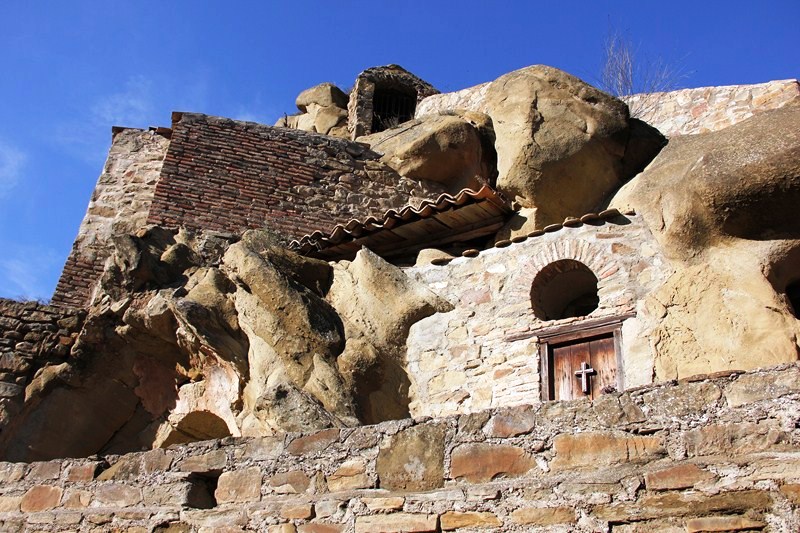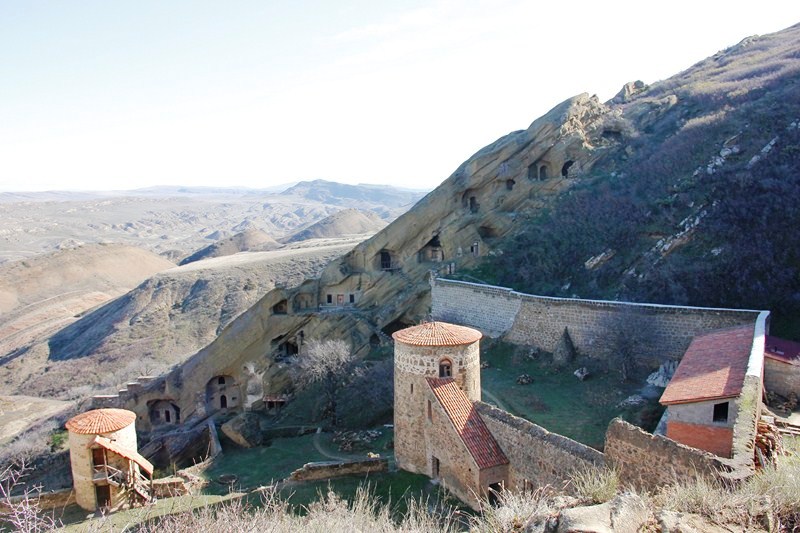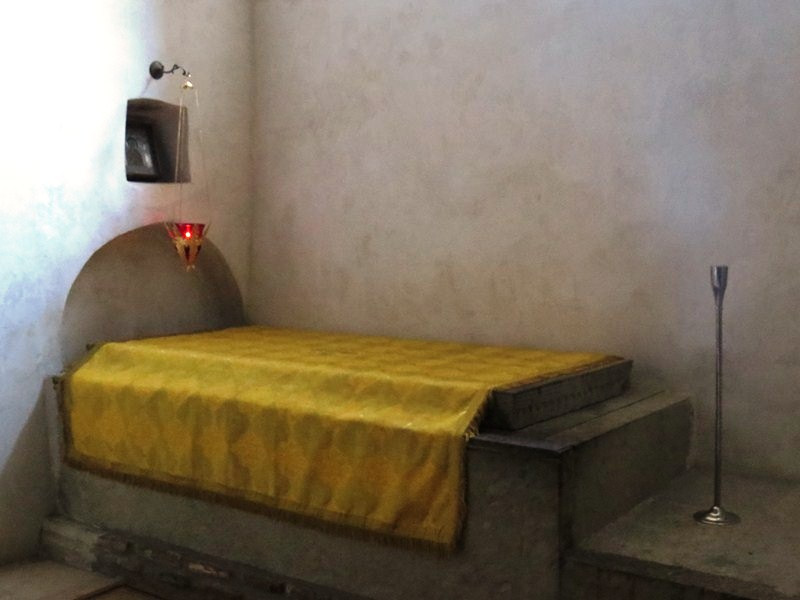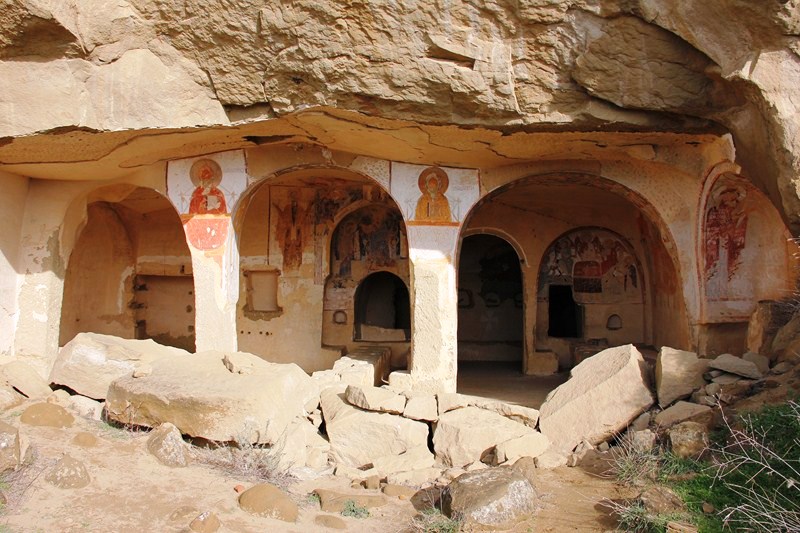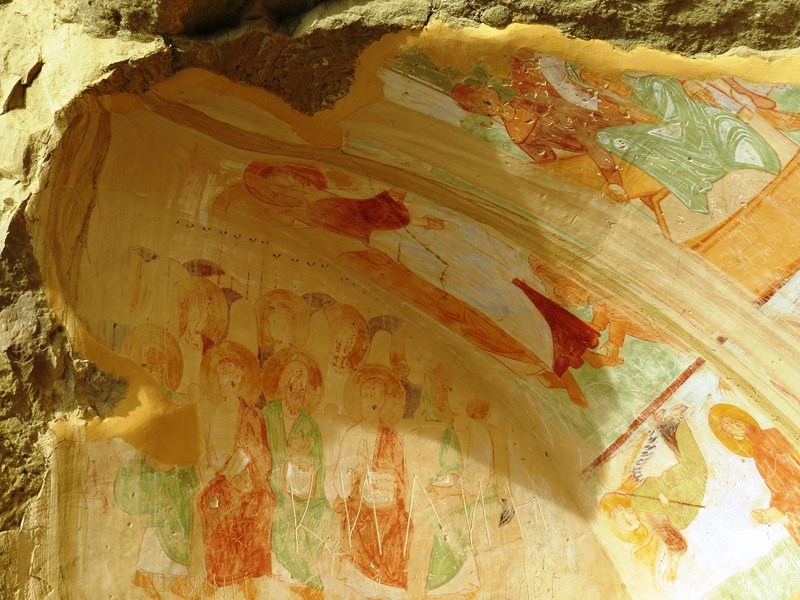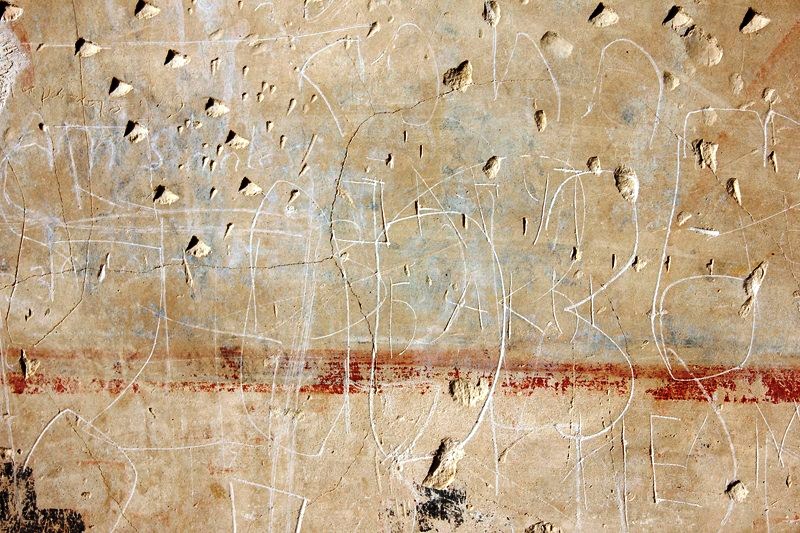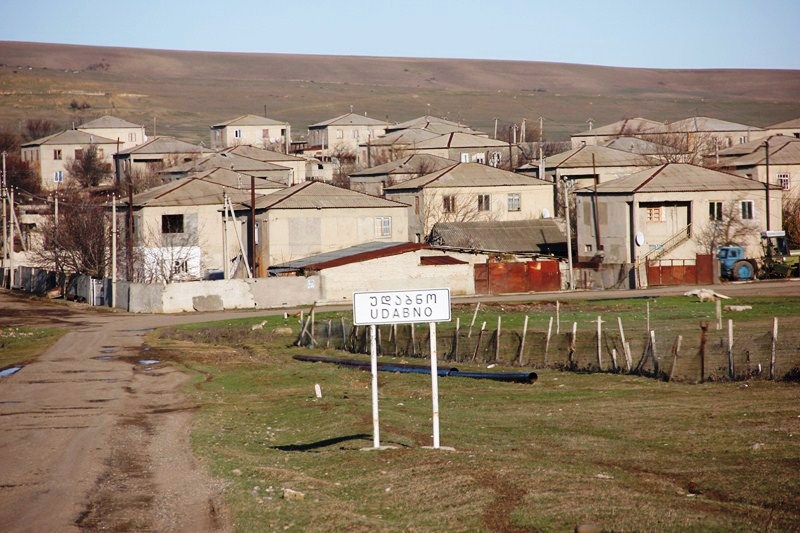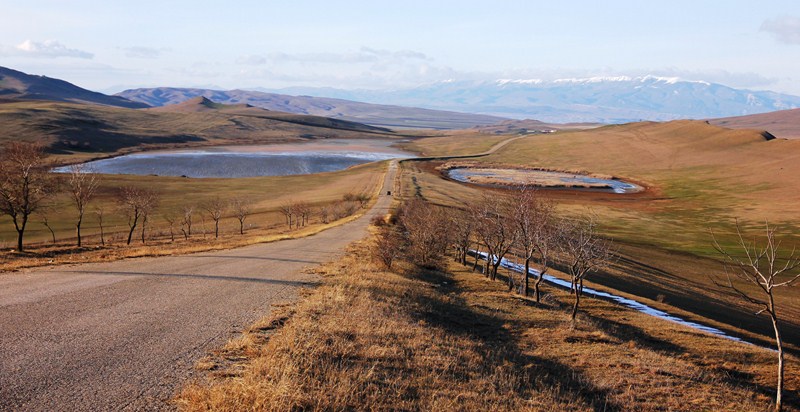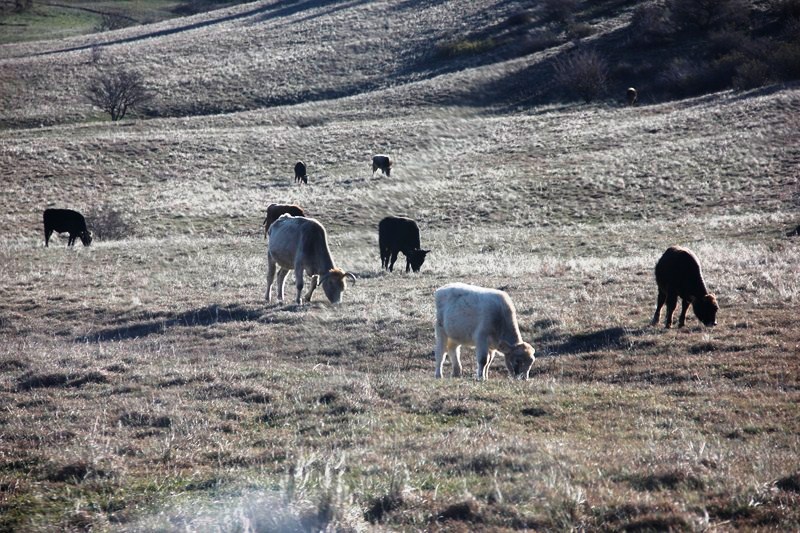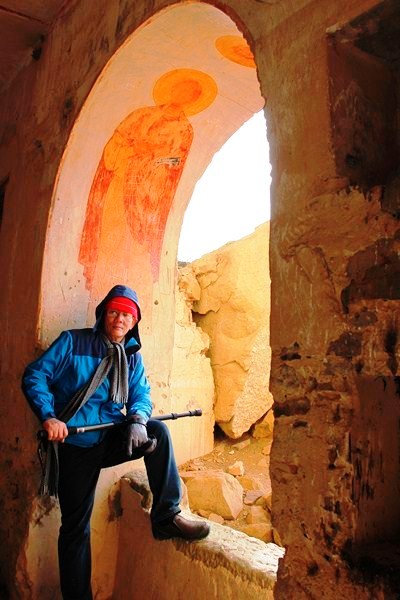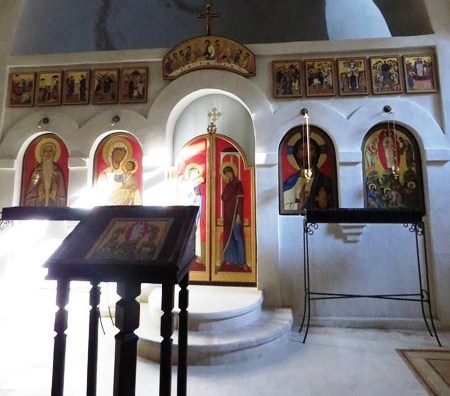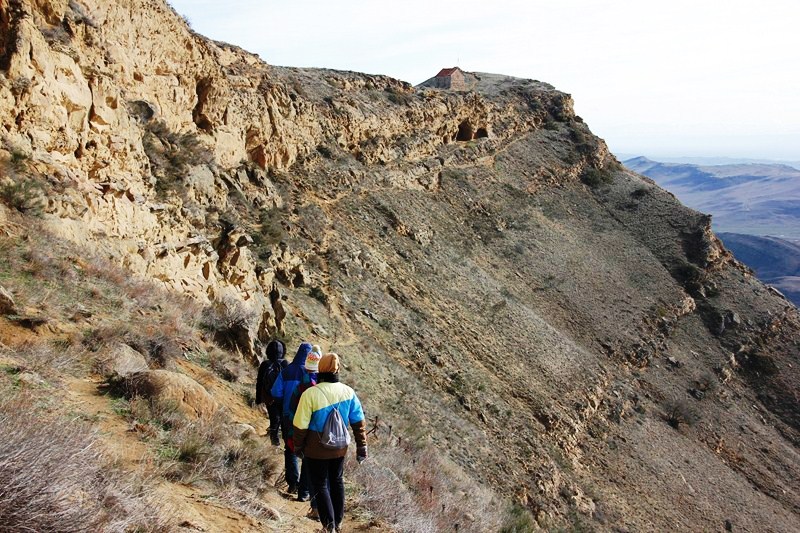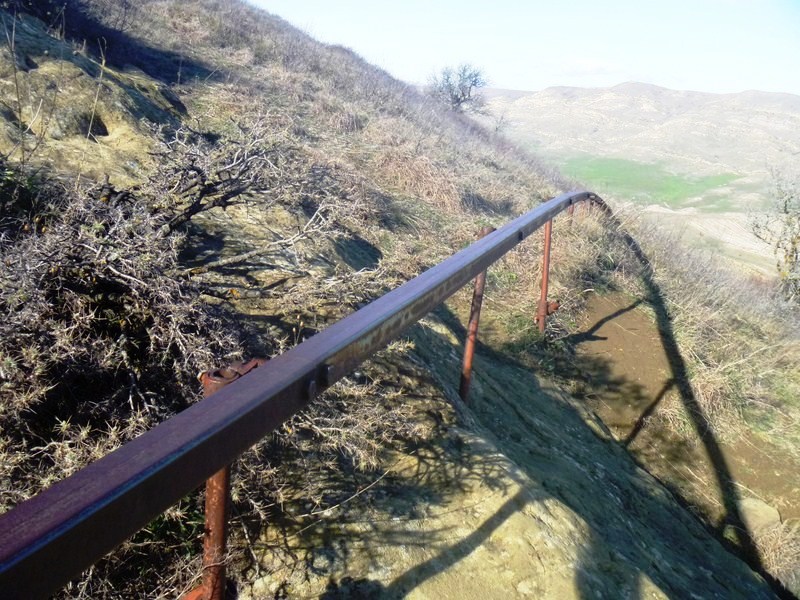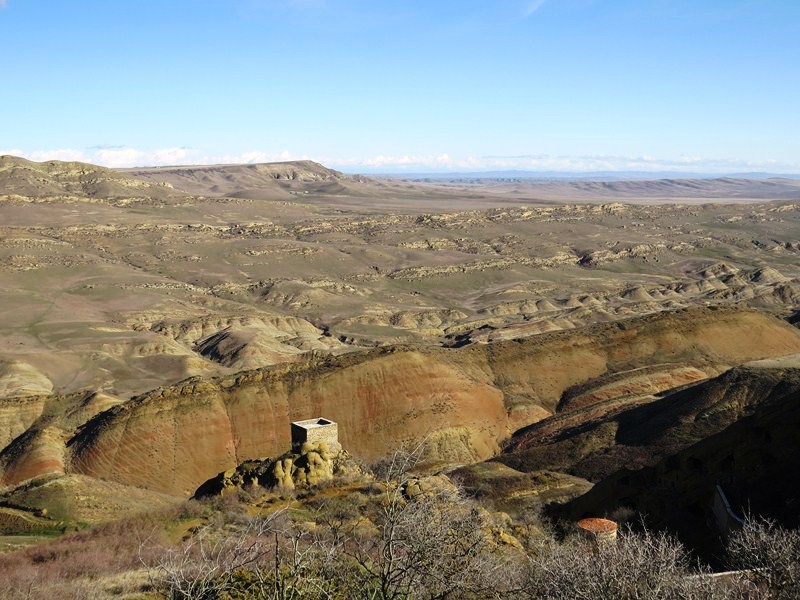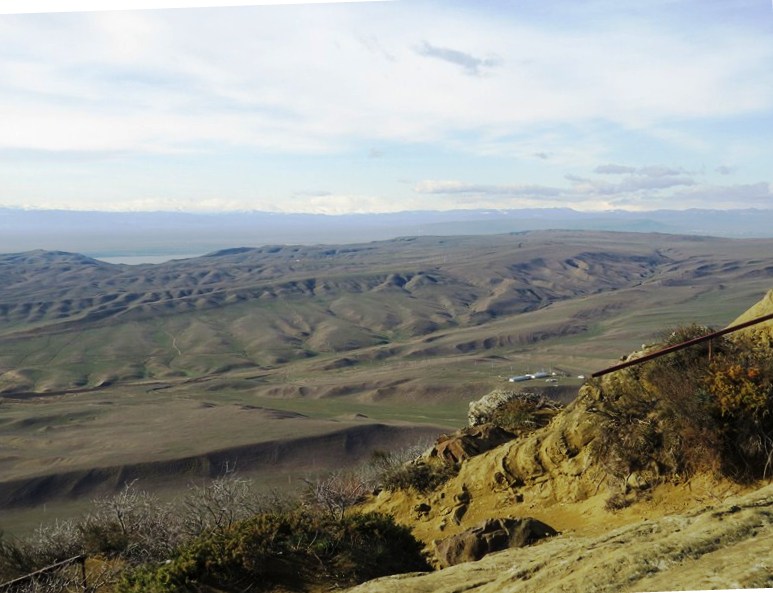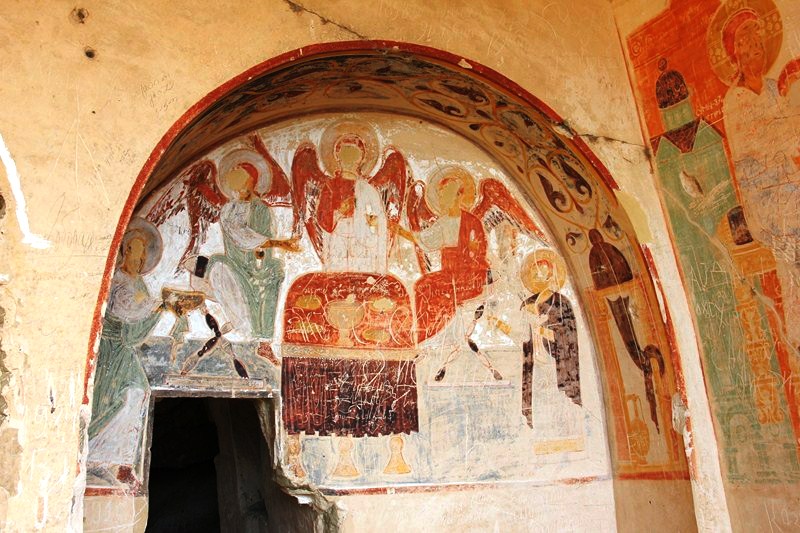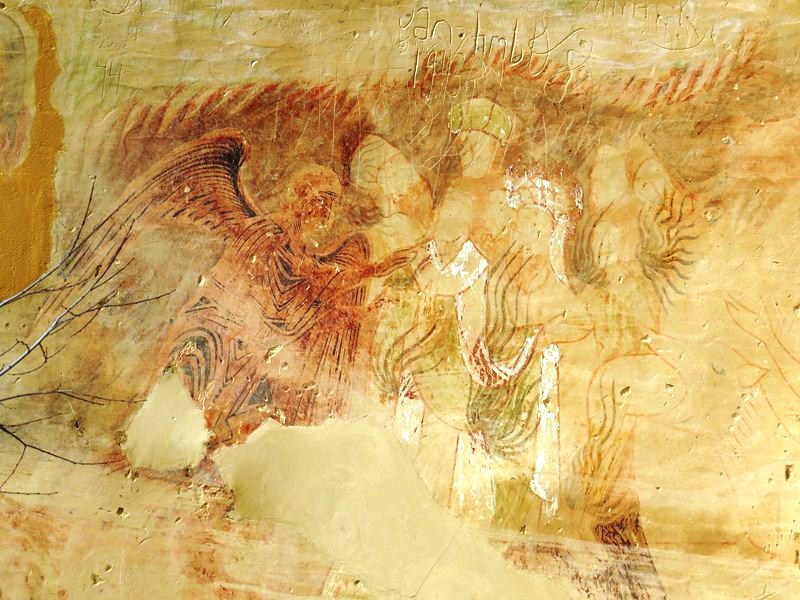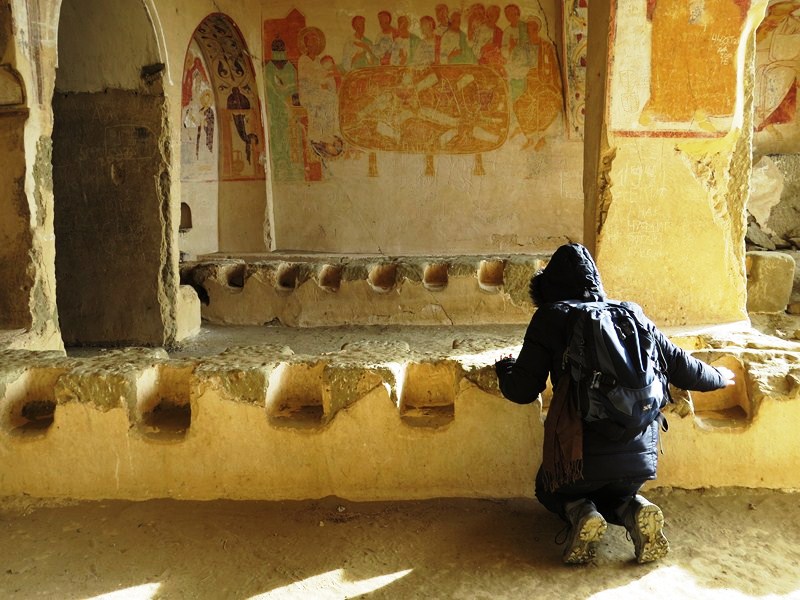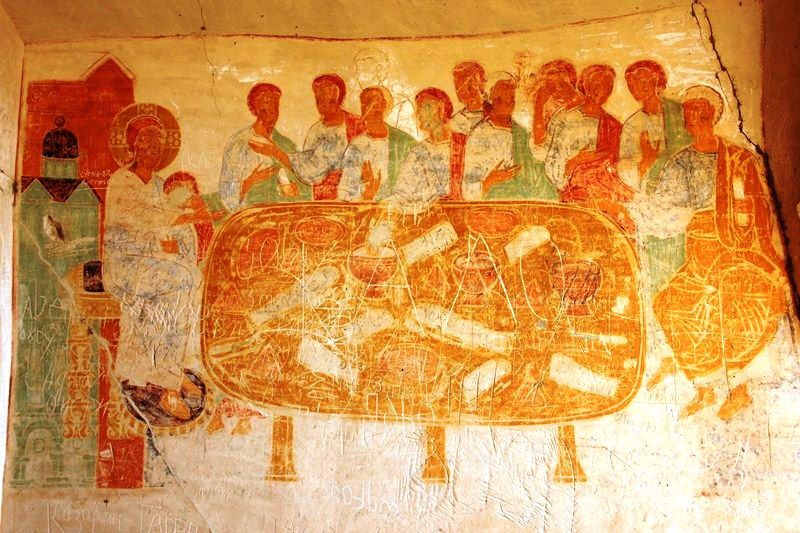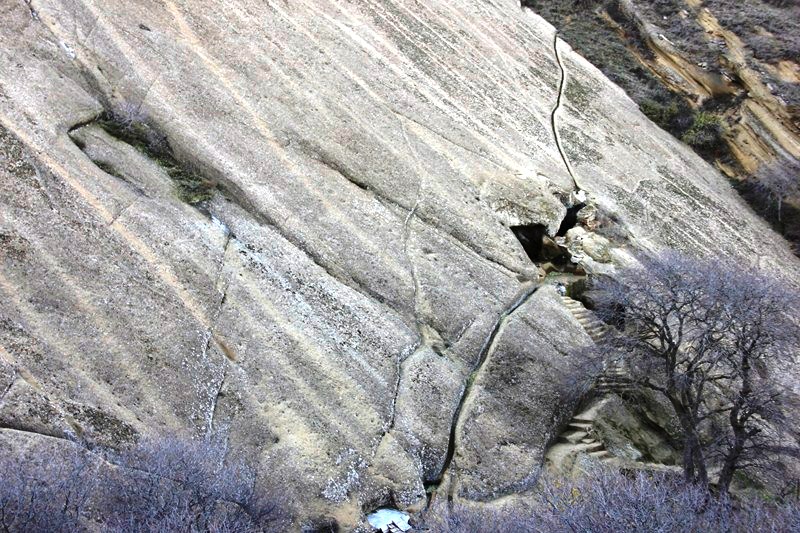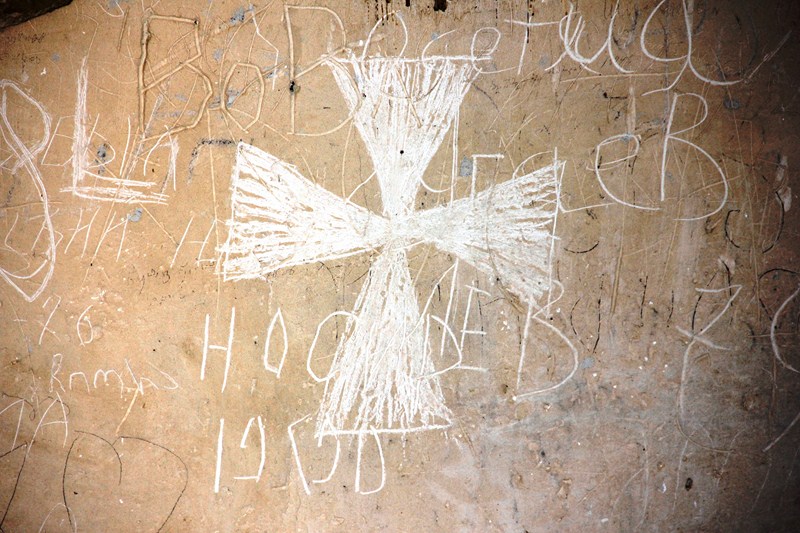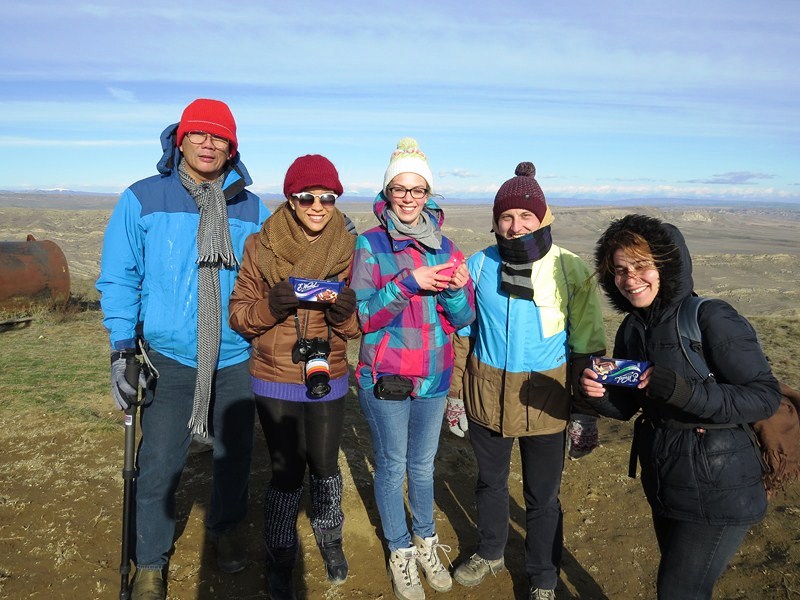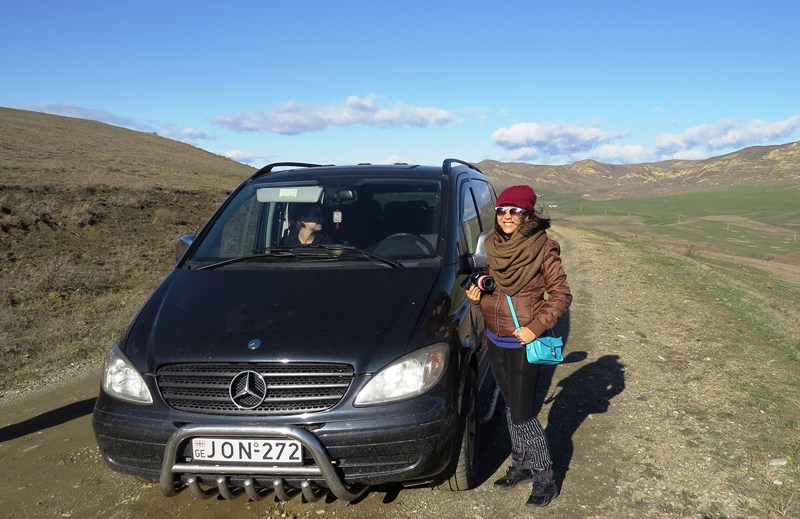(All photos courtesy of Ms. Riva Galveztan)
After finishing our GNTA-sponsored tour of the Georgian countryside the day before, Riva and I again hired our trusted Georgian guide Sopho Makashvili to again tour us, this time to David Gareja (sometimes spelled Davit Gareja), the rock-hewn Georgian Orthodox monastery complex located in the Kakheti region of Eastern Georgia, After breakfast, the next day, we again met up with Sopho at Meidan Square and all three of us boarded the Mercedes Benz Vito panel van of our driver Giorgi.
The complex was founded in the 6th century by St. David Garejeli (who came with pupil Luciane), one of the Thirteen Assyrian monks from Mesopotamia who arrived in Georgia at the same time to strengthen Christianity. Many monasteries in modern Georgia are named after the Assyrian Fathers. David was drawn to the desolation and purity of Kakheti. Luciane and Dodo, another of David disciples, expanded the original Lavra monastery and also founded two other monasteries – Dodo’s Rka (literally, “the Horn of Dodo”) and Natlismtsemeli (“the Baptist“).
Under the guidance of the 9th-century Georgian saint Ilarion, the monastery also saw further development. Its convent was particularly patronized by the Georgian royal and noble families. After he abdicated the throne, the 12th-century Georgian king Demetre I (the author of the famous Georgian hymn Thou Art a Vineyard) chose David Gareja as a place of his confinement.
For many centuries, despite its harsh environment, the monastery remained an important center of religious and cultural activity and, at certain periods, it owned extensive agricultural lands and many villages. The renaissance of fresco painting chronologically coincides with the general development of the life in the monasteries. From the late 11th to the early 13th centuries, the economic and cultural development of David Gareja reached its highest phase, with new monasteries (Udabno, Bertubani and Chichkhituri) being built and old ones being enlarged and reorganized.
With the downfall of the Georgian monarchy, the monastery suffered a lengthy period of decline. In 1265, it was devastated by the Mongol army. Later restored in the early 14th century by Giorgi V the Brilliant, it was sacked by Timur and survived the Safavid Persian attack of Shah Abbas I on Easter night of 1615 when over 6,000 monks were massacred and the monastery’s unique manuscripts and important works of Georgian art were destroyed. The monastery was resurrected under Onopre Machutadze, who was appointed Father Superior of David Gareja in 1690.
After the violent Bolshevik takeover of Georgia in 1921, the monastery was closed down and remained uninhabited. In the years of the Soviet War in Afghanistan, the monastery’s territory was used as a training ground and military firing range for the Soviet army because of its supposed resemblance to the hills of the Afghan war zone. As a result, it inflicted damage to the unique cycle of murals in the monastery. After the restoration of Georgia’s independence in 1991, the monastery life in David Gareja was revived. The monastery remains active today and serves as a popular destination of tourism and pilgrimage.
There are two options to get to this isolated and once restricted area – either via Sagarejo (with a road in an acceptable state) or via Rustavi. We went there via the latter. From Tbilisi, we were driven southeast, to the half-desert slopes of 2,432 m. (7,979 ft.) high Mt. Gareja, passing by Udabno, a village inhabited by 200 families, mostly Svans who moved here in the beginning of the 1990s because of an ecological disaster. The silence here feels inherent, with a lot of the concrete houses empty and their doors broken. The village’s Oasis Club Restaurant, a watering hole frequented by visitors, was closed for the winter.
The road we travelled on was in a very bad state, washed out to bare rock in some places, but easily traversed by 4-wheel drive vehicles. It goes through a vast and bleak, semi-arid but very dramatic landscape of scrub grasslands and hills occasionally interspersed with salt lakes (a refuge for migratory birds), truly one of the most memorable places I have ever visited.
There’s not much living here in this stretching steppe besides birds of prey and the rare lone shepherd tending his flock of sheep. I imagined, at one point several thousand years ago, it must have been covered in forest before early man chopped the trees down in search of iron ore and wood, forever changing its micro climate.
After some 60–70 kms. and 2 hours of driving, we finally arrived at David Gareja. It snowed the day before, but it was sunny during our visit. Still, blustery winds made it seemed we were in sub-zero temperatures. The complex consists of hundreds of hermit cells, churches, chapels, refectories and living quarters hollowed out of the rock face. It has been subject to a border dispute between Georgia and Azerbaijan.
Part of the complex is located in the Agstafa Rayon of Azerbaijan with a border fence literally built into the hillside. The area is also home to protected animal species and evidence of some of the oldest human habitations in the region. David Gareja is actually named for 12 monasteries in the immediate area but we were to only visit the monasteries of Davit Lavra (the only inhabited one today) and Udabno.
Our van was parked in a small lot in front of the fully functional main monastery of Lavra which has undergone substantial renovation. Sopho, Riva and I were accompanied by Giorgi. Here, we visited most of its rooms. The rooms not allowed for tourists are clearly marked with “no entrance” signs, in both English and Georgian. Inside the church we saw the tomb of St. David Garejeli. Outside the monastery is dry rock in reds, yellows and even pale blues stretching across the landscape.
The trail leading to the second monastery of Udabno (meaning “desert” or “wilderness” in English), high up on a bluff on the other side of the hill, was rather very steep, uneven and difficult, involving some scrambling over loose dirt and rocks in places. Luckily, I wore good and comfortable hiking shoes as well as brought my trekking pole (actually a monopod). Spraining your ankle would be really bad news here. The tough but manageable hike up took over an hour.
During our hike, we were joined by newly-arrived Polish couple Adrian Siesicki and Katarzyna Siesicka who hired a taxi to get to David Gareja. Along the way, we passed what remains of an uncompleted monorail started during Soviet times to carry passengers all the way up to the caves on the southern side. After zigzaging up the bottom half of the hill, our trail more or less followed the monorail’s line. Once on top, we had a wonderful view towards both Georgia and Azerbaijan, a vast valley 300 m. below that stretches away for miles. The view from here was worth the climb alone.
On our way back, we saw many of the troglodyte churches of Udabno Monastery consisting of numerous caves carved into the rock, beside which are sheer unguarded drops. There are no guardrails. Some are more destroyed than others but still contain traces of faded frescoes depicting angels, apostles, etc. from the 11th to 14th centuries, some just a few feet within cave walls.
Some are even found on exterior surfaces. The old monk’s refectory has a strangely carved rock along the floor that was once a low table. The wall above has a 10th century depiction of The Last Supper.
The descent provided us with great views of the surrounding landscape. Along the way, we passed by “David’s Tears,” the only spring in the area. This system of crevices, a unique hydro technical system used to collect the maximum amount of water during periods of rain (only 20-30 liters of water can be collected diurnally), was cut by the monks across sheets of rock on a steep mountain slope.
The high artistic skill of David Gareja’s frescoes (a celebrated Georgian school of fresco painting and manuscript illustration flourished here), an indispensable part of world treasure, has undergone nearly a thousand years of noticeable graffiti which has, together with erosion due to wind and sand and Russian artillery fire, taken its toll on some of the images which are unprotected by doors and open to the elements.
The story of how the monks came to live here is really fascinating and the great thing about the hauntingly historic, simple but charming David Gareja complex is that there has been little or no attempt to exploit it for tourism. What we saw was raw Nature without virtually any kind of facilities, thereby enjoying the peace, quiet, and remoteness of the place. It further proves my point – if you want to see amazing places with very few other tourists around, come to Georgia. According to a long held belief, they say that visiting David Gareja three times is equal to a pilgrimage to Jerusalem. In that case, I am already a third of the way to the Holy City.
David Gareja: Mt. Gareja, Udabno, Georgia. During the hot season, bring lots of water and beware of red, blunt-nosed poisonous vipers. Public toilets (a small house with a red roof), some 100 m. before the entrance, are very basic. The lunar, semi-desert landscape turns green and blooms with flowers in early summer.
How To Get There: From April 14 to October 15, there is an inexpensive (25 GEL) daily tour, via a direct marshrutka (shuttle bus) of Gareji Line, going from and back to Tbilisi.
Qatar Airways has daily flights from Diosdado Macapagal International Airport (Clark, Pampanga) to Tbilisi (Republic of Georgia) with stopovers at Hamad International Airport (Doha, Qatar, 15 hrs.) and Heydar Aliyev International Airport (Baku, Azerbaijan, 1 hr.). Website: www.qatarairways.com.

